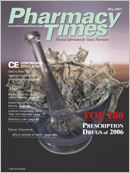Publication
Article
Pharmacy Times
Pseudoephedrine Logs Need Constant Tending
Author(s):
The laws of many states, and nowthe federal government, restrictthe sale of pseudoephedrine bylimiting the amount purchased permonth and by requiring photo identificationand the signing of a log at the pharmacyor retail outlet. Of course, it is nosecret that this is in place to help curbthe domestic production of methamphetamine,since pseudoephedrine is anecessary precursor.
This new regulation has drasticallyreduced the number of methamphetaminelaboratories in some areas of theUnited States. In my own county in southwestOhio, we discovered 23 labs in 2005and only 4 in 2006. All 4 of the labs in2006 were found prior to the state'spseudoephedrine law taking effect. Inearly 2007, however, we encountered 3separate methamphetamine labs, 75% ofthe total of all of last year.
At the same time that the number oflabs was increasing, one of my undercoverofficers began to buy small amountsof methamphetamine and large amountsof pseudoephedrine products from alocal gas station/convenience storeowner. He was the co-owner of a busystore near one of our major interstatesand, through a relative, had access to 3more stores in the region. During thesales, we made it clear that we werebuying the pseudoephedrine products tomanufacture meth.We were also payingalmost 10 times the amount for the productsthan what you could buy them for atany pharmacy.
At the time of his arrest and the serviceof search warrants at the store andhis residence, we found over 45,000tablets of pseudoephedrine productsand discovered that he and his relativehad ordered well over 100,000 tabletsover the past months in the 4 stores.When we requested the sign-in logs foreach of the stores, the 2 store ownerswere unable to produce any logs for thepast 9 months, when we had documentedproof that these pills had beendelivered.
In checking with the out-of-state distributor,we found documentation oflarge weekly deliveries to each of thestores, with no real scrutiny except thesignature of the store owners on a documentadvising them ofthe restrictions on thedistribution of pseudoephedrineproducts. Thenumber of pseudoephedrinesales we coulddocument was estimatedto have been able toproduce several kilos ofmethamphetamine, withthe ultimate street valueof well over $500,000.
So who is at fault here, and how canwe thwart this kind of illegal activity?Ultimately, of course, it is the store ownerswho are committing the criminalactivity, but the distributors need toaccept some responsibility when nochecks and balances are in place, especiallywhen sales for particular stores arenot in line with other establishments.Some duty exists to report this kind ofexcessive purchase of this product.
Law enforcement also may takesome blame here for not checking sign-inlog records, but Ohio made this crimea very low misdemeanor—with analmost impossible task of checkingthese records in stores. In addition, ourarea of the country is bordered byIndiana and Kentucky, making thechecking of these records even moredifficult—even if the time and personnelwere available. This creates someinterest in computerizing pseudoephedrinesales—possibly by incorporatingthem into prescription-monitoringprograms.
I would ask all of you to be seriousabout your pseudoephedrine log andeducate the people who have accessto these products behind the counter.Pseudoephedrine products are nowworth much more than their retail value,making clandestine sales a temptationfor some employees. Knowwhat you have ordered and that yourretail sales match the amount thatcomes into your pharmacy everymonth. Do not take discrepancieslightly, and either investigate them ornotify someone who has that responsibility.Because of the devastatingeffects of methamphetamine addiction,keeping track of pseudoephedrinetablets in your pharmacy isan important task—one that very wellmay save a life.
John Burke, commander of the Warren County, Ohio,drug task force and retired commander of the CincinnatiPolice Pharmaceutical Diversion Squad, is a 38-yearveteran of law enforcement.Cmdr Burke also is the current president of theNational Association of Drug DiversionInvestigators. For information, he can bereached by e-mail at [email protected], viathe Web site www.rxdiversion.com, or byphone at 513-336-0070.

Newsletter
Stay informed on drug updates, treatment guidelines, and pharmacy practice trends—subscribe to Pharmacy Times for weekly clinical insights.






